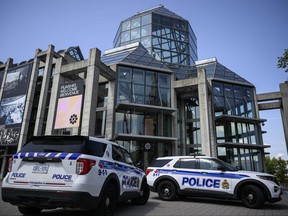Punish him. Make it hurt.
Art
KINSELLA: Thomson’s extraordinary art on receiving end of extraordinary idiocy

A “climate activist,” some media called him. A “terrorist,” others might call him.
I come from a family of artists, you see. “Art is the greatest form of hope,” the British artist Banksy once said, and it’s true. To deface Thomson’s painting — which took two years to complete and is considered one of the greatest works of art ever produced in this country — was to deface hope itself.

My initial reaction, I confess, was that someone should break the fingers and arms of the paint-thrower, so that they can never do it again. I was that angry.
But, no. That’s extreme. That’s the kind of thing the Taliban does, isn’t it? Ironically, the paint-throwers share quite a bit in common with the Taliban, the fundamentalist Islamic terrorist group that now rules over Afghanistan. They try to murder art, too.
The Taliban burn books, prohibit music and — infamously — kill works of art. Upon seizing power in the 1990s, the Taliban systematically and efficiently destroyed thousands of works of art at the Afghan National Museum and elsewhere because they were “un-Islamic.”
In all, 70% of the museum’s artifacts — some 100,000 individual works — were destroyed by the Taliban. In 2001, they obliterated the giant Buddhas of Bamiyan because they were considered un-Islamic and blasphemous. The statues were more than a 1,000 years old.
And, of course, fascists and extremists often target art first. The Nazis destroyed thousands of works of art by cubists, expressionists and impressionists in Germany and France — because they considered them “degenerate.”
So this week’s attack on Thomson’s masterwork is not without precedent. (It was not permanent, either; glass protected it from permanent damage.) Lunatics and monsters are always using beautiful works of art to make a political statement.
And Thomson’s Northern River is unquestionably beautiful. It is extraordinary.
It’s not known where Thomson saw what would later become Northern River. Algonquin Park formed the subject matter of many of his masterpieces, of course, but a friend of Thomson’s later said it wasn’t a scene from there. So it could be anywhere in Canada, really.
Why would anyone want to destroy something like that? Why attack beauty? Why would they smear paint on it?
Maybe. Perhaps. But the ones who try to destroy art that depicts the very environment that On2Ottawa claims to be concerned about?
They’re the ones who were the most immoral this week.

Art
40 Random Bits of Trivia About Artists and the Artsy Art That They Articulate – Cracked.com
[unable to retrieve full-text content]
40 Random Bits of Trivia About Artists and the Artsy Art That They Articulate Cracked.com

Source link
Art
John Little, whose paintings showed the raw side of Montreal, dies at 96 – CBC.ca
[unable to retrieve full-text content]
John Little, whose paintings showed the raw side of Montreal, dies at 96 CBC.ca

Source link
Art
A misspelled memorial to the Brontë sisters gets its dots back at last

LONDON (AP) — With a few daubs of a paintbrush, the Brontë sisters have got their dots back.
More than eight decades after it was installed, a memorial to the three 19th-century sibling novelists in London’s Westminster Abbey was amended Thursday to restore the diaereses – the two dots over the e in their surname.
The dots — which indicate that the name is pronounced “brontay” rather than “bront” — were omitted when the stone tablet commemorating Charlotte, Emily and Anne was erected in the abbey’s Poets’ Corner in October 1939, just after the outbreak of World War II.
They were restored after Brontë historian Sharon Wright, editor of the Brontë Society Gazette, raised the issue with Dean of Westminster David Hoyle. The abbey asked its stonemason to tap in the dots and its conservator to paint them.
“There’s no paper record for anyone complaining about this or mentioning this, so I just wanted to put it right, really,” Wright said. “These three Yorkshire women deserve their place here, but they also deserve to have their name spelled correctly.”
It’s believed the writers’ Irish father Patrick changed the spelling of his surname from Brunty or Prunty when he went to university in England.
Raised on the wild Yorkshire moors, all three sisters died before they were 40, leaving enduring novels including Charlotte’s “Jane Eyre,” Emily’s “Wuthering Heights” and Anne’s “The Tenant of Wildfell Hall.”
Rebecca Yorke, director of the Brontë Society, welcomed the restoration.
“As the Brontës and their work are loved and respected all over the world, it’s entirely appropriate that their name is spelled correctly on their memorial,” she said.
The Canadian Press. All rights reserved.
-

 News14 hours ago
News14 hours agoA tiny grain of nuclear fuel is pulled from ruined Japanese nuclear plant, in a step toward cleanup
-

 Economy23 hours ago
Economy23 hours agoHealth-care spending expected to outpace economy and reach $372 billion in 2024: CIHI
-

 News14 hours ago
News14 hours agoCanadanewsmedia news November 07, 2024: Canada’s health-care spending to reach $372 billion in 2024
-

 Sports14 hours ago
Sports14 hours agoDeMar DeRozan scores 27 points to lead the Kings past the Raptors 122-107
-

 Sports14 hours ago
Sports14 hours agoPWHL unveils game jerseys with new team names, logos
-

 News14 hours ago
News14 hours agoWho ruined Hobo Hot Springs? Ministry investigates as mystery roils Harrison, B.C.
-

 Sports23 hours ago
Sports23 hours agoSaskatchewan’s Jason Ackerman improves to 6-0 at mixed curling nationals
-

 News8 hours ago
News8 hours agoAlberta forestry minister says wolverine, lynx trapping limits lifted to gather data





















